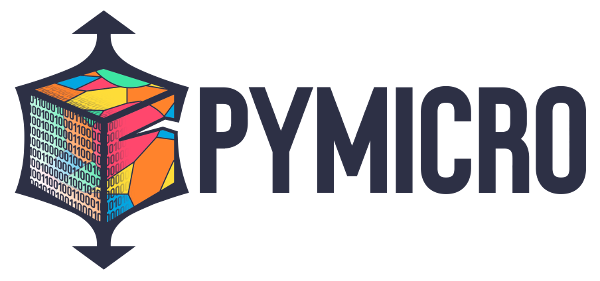
Pymicro is an open-source Python package to work with material microstructures and 3d data sets.

Introduction¶
pymicro is a python library to load, study and vizualize three dimensional material data with a particular focus on crystalline microstructures. It combine the generic power of the main scientific python libraries (namely numpy, scipy and matplotlib) with the 3D visualisation capabilities of a state of the art library as VTK. The goal of pymicro is to make it easy (or easier) to process your 3D datasets especially when it comes to automated processing needed for in situ data analysis.
Contents:
- Overview
- Installation
- Dependencies
- External
- API documentation
- Pymicro Data Platform: The Sample Data and Microstructure Classes User Guide
- 1 - Introduction to the SampleData data platform
- 2 - Getting started with SampleData : Exploring dataset contents
- 3 - Creating and retrieving basic data items
- 4 - Creating, getting and visualizing Image Groups and Image Fields
- 5 - Creating, getting and visualizing Mesh groups and Mesh Fields
- 6 - Data Compression
- 7 - Sample Data Inheritance - The Microstructure Class
- SampleData Quick Reference Sheet
- Examples
- Cookbook
- Using pymicro interactively
- How to read 3d files properly and ensure consistency of the coordinate system?
- 3d analysis and rendering of damage in a steel tension sample
- Convention to read and write 2d images with pyplot
- Understanding Euler angles and the orientation matrix
- Image alignment by point set registration
- Atomic Scattering Factors for X-rays
- pymicro Package
- Change log history
- pymicro version 0.5.3
- pymicro version 0.5.2
- pymicro version 0.5.1
- pymicro version 0.5.0
- pymicro version 0.4.5
- pymicro version 0.4.4
- pymicro version 0.4.3
- pymicro version 0.4.2
- pymicro version 0.4.1
- pymicro version 0.4.0
- pymicro version 0.3.3
- pymicro version 0.3.2
- pymicro version 0.3.1
- pymicro version 0.3.0
- pymicro version 0.2.3
- pymicro version 0.2.2
- pymicro version 0.1.0
- References